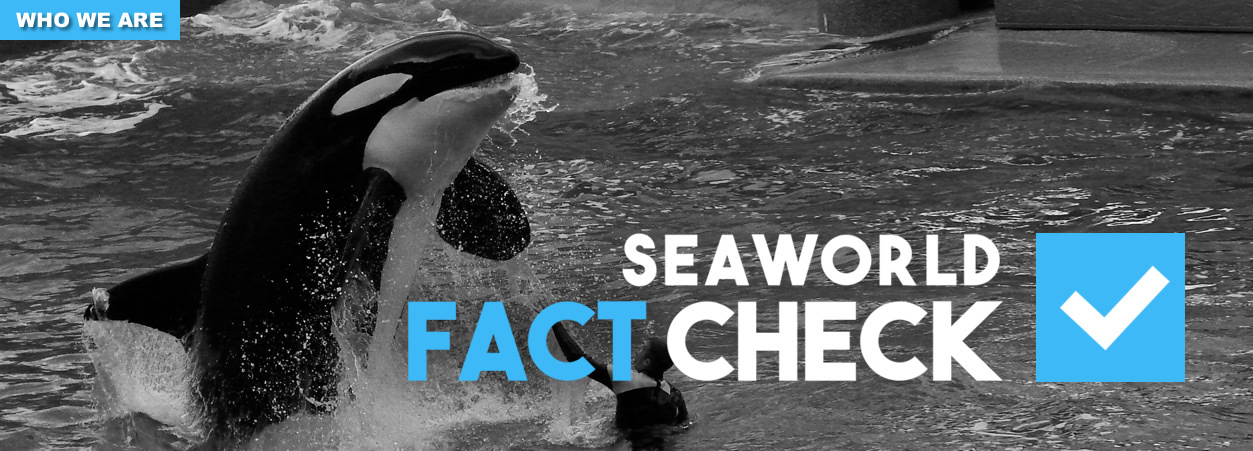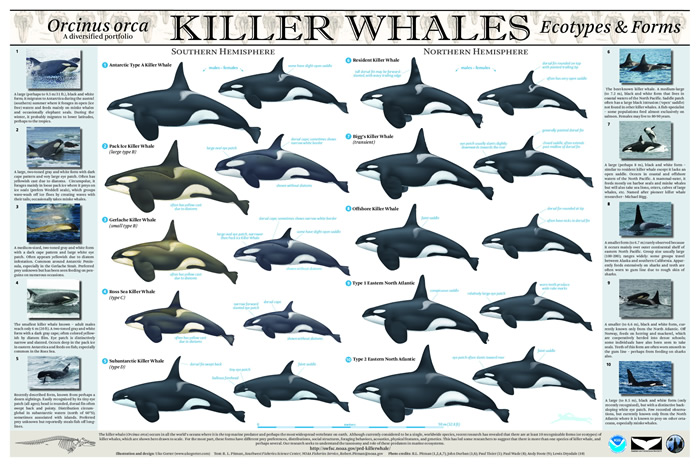

|

SEAWORLD FACT CHECK:
SeaWorld's response to this question considers only physiological aspects of orca breeding cycles. However, in social mammals, anestrus and body condition are not the only factors determining calving intervals.
Social mammals may have social or behavioral mechanisms that prolong the calving interval beyond the point where the mother is physiologically capable of reconceiving, such as a learning period during which an offspring acquires valuable social or behavioral skills (see, e.g., Baird 2000). This is the case with orcas; the average five-year calving interval measured in free-ranging resident orcas is longer than the lactation period (weaning appears to occur around 1-2 years of age) (Ford 2009) and has likely evolved because this is the optimum interval for mothers to teach their offspring adequate skills before diverting their attention to a subsequent calf.
Females (of any mammal species) who become pregnant too young or too often can experience physical harm that shortens their lives (see, for example, Kirkpatrick and Turner 2007). At SeaWorld both occur – the company begins breeding its female orcas as soon as they are physiologically capable of conception (as young as six years of age), whereas in the wild the average age at first observed birth is about 12-14 years of age (meaning conception occurs at 10-12) (Ford 2009). Free-ranging females are likely able to conceive for the first time sooner than they actually do, just as in humans; there is often a difference of several years between sexual and social maturity in complex, social mammals. Social mechanisms prevent young females from mating before they are mature enough to raise offspring appropriately. SeaWorld also often breeds its females as soon as they are capable of reconceiving (often less than two years after the birth of their current calf).
In conclusion, SeaWorld’s breeding program does not allow offspring sufficient time to learn social or behavioral skills from their mothers, begins breeding female orcas years before they are socially or behaviorally ready, and impregnates females too soon after a previous birth. All of these practices may harm captive orcas’ psychological and physical health.
References:
Baird, R.W. 2000. The killer whale. pp. 127-153. In: J. Mann, R.C. Connor, P.L. Tyack, and H. Whitehead (eds.) Cetacean Societies, University of Chicago Press: Chicago. 433 pp.
Ford, J.K.B. 2009. Killer whale. pp. 650-657. In: W.F. Perrin, B. Wursig, and J.K. Thewissen (eds.) Encyclopedia of Marine Mammals (2nd edition), Academic Press: New York, NY. 1316 pp.
Kirkpatrick, J.F. and Turner, A. 2007. Immunocontraception and increased longevity in equids. Zoo Biology 26: 237-244.
_____________
SEAWORLD SAYS:
The following is an answer from Todd Robeck, DVM, PhD, Vice President of Theriogenology at SeaWorld:
All killer whales have a physiologic mechanism, just as humans and other animals do, which determines when they are ready to become pregnant again. Simply put, they cannot breed if they are not ready.
The ”five-year” period you are referring to is called a calving interval.
This is not a waiting period, but a time during which certain physiologic events are taking place. The first is a suckling calf. During the period when a calf is nursing, killer whales (and other mammalian species) go through a period of non-reproductive activity termed anestrus. When this period is associated with nursing it is termed “lactational anestrus”. This is a common phenomena in many mammals and the time duration typically depends on how long a calf nurses. Killer whales nurse one to two years¹. The body condition of the cow after nursing a calf may be another important measure for determining when her body starts its reproductive activity again. Sometimes, for unknown reasons, animals will not cycle for many years after delivering a calf that is no longer nursing.
At SeaWorld the average calving interval of four years is not statistically different than that of the Northern and Southern Resident killer whales of five years. More data is needed, but if this observed difference is real it may be related to the steady nutrition that SeaWorld whales receive as compared to the varied availability of prey for wild whales.
Source:
1 Robeck et al., Zoo Biology 1993;12:173-188 |

|
SEAWORLD FACT CHECK:
The word “pod” can be generic, referring to any group of cetaceans1. This is the sense in which SeaWorld uses the term. When referring to orcas, however, the term has additional meaning; it refers to an essential social unit within an orca population.
Ford (2009) defines an orca pod as “a group of related matrilines that likely shared a common maternal ancestor in the recent past” (p. 652). In short, orca pods share not only feeding habits but genes and also dialects (i.e., family members speak the same language). SeaWorld ignores the kinship element of orca pods in its response.
References:
Ford, J.K.B. 2009. Killer whale. pp. 650-657. In: W.F. Perrin, B. Wursig, and J.K. Thewissen (eds.) Encyclopedia of Marine Mammals, 2nd ed., Academic Press: New York, NY.
1 http://www.thefreedictionary.com/pod
_____________
SEAWORLD SAYS:
Pod size can vary tremendously. In the eastern North Pacific Ocean, pod size varies from just two or three to more than 100 individuals. In general, Resident pods are larger than transient pods. Resident pods usually include between five and 50 whales. Transient pods usually include only seven whales or less. In fact, some Transient adult males are solitary. Offshore killer whales are sighted in varying group sizes, from less than 20 to more than 100 individuals.
Scientists theorize that these differences in pod size are related to the whales’ feeding habits. A large pod size may be best for herding and hunting schools of fish, and a small pod may be best for hunting marine mammals. |

SEAWORLD FACT CHECK:
SeaWorld states that the “lineage of SeaWorld’s killer whales includes two main ecotypes: the Pacific Northwest and the North Atlantic.” As the poster by NOAA (included in SeaWorld’s response) clarifies, there are no such ecotypes. SeaWorld whales descend from the Resident ecotype (found in the northeastern Pacific, feeding predominantly on salmon (Ford 2009)), the Bigg’s or transient ecotype (found in the same range as the Residents, feeding predominantly on marine mammals (Ford 2009)), and the Type 1 North Atlantic ecotype (found in the North Atlantic, including Iceland, feeding predominantly on mackerel and herring; its social structure and behavior are similar to Residents (Foote et al. 2009)). There is also a Type 2 North Atlantic ecotype, which feeds on marine mammals
and is similar to Bigg’s ecotype (see NOAA poster).
References:
Ford, J.K.B. 2009. Killer whale. pp. 650-657. In: W.F. Perrin, B. Wursig, and J.K. Thewissen (eds.) Encyclopedia of Marine Mammals (2nd edition), Academic Press: New York, NY. 1316 pp.
_____________
SEAWORLD SAYS:
Scientists currently recognize at least 10 killer whale ecotypes. These ecotypes have overlapping geographic ranges in certain areas and slight genetic variations. They sometimes have distinct differences in size, habitat, color pattern, dorsal fin shape, vocalizations, diet, and hunting strategies.

Source: NOAA
Experts identify killer whale populations based on the whales’ call patterns, behavior, body shape, and coloration. Current and future studies analyzing biochemical and genetic characteristics may help distinguish relationships between pods and regional populations of killer whales.
The lineage of SeaWorld’s killer whales includes two main ecotypes: the Pacific Northwest and the North Atlantic.
|

|
SEAWORLD FACT CHECK:
SeaWorld’s response to this question is substantively accurate, until the final paragraph. SeaWorld states that, “Even for those whales that are more widely distributed across their range, it is incorrect to see them as always on the move.” In fact, free-ranging cetaceans, including all orca ecotypes, are indeed always moving, even when they sleep (Lyamin et al. 2008; Ford et al. 1994). “Minimal” daily movement for resident orcas may equate to several linear miles within their home range; orcas can easily travel 100 linear miles in 24 hours (Baird 2000). While the reason for traveling these distances is generally tied to prey movements, orcas are nevertheless adapted to such movements. When they are denied the opportunity to move these distances, they almost certainly suffer physiologically, just as human beings do when they adopt an essentially sedentary (“couch potato”) lifestyle.
When any ecotype of orca “settle[s] in and take[s] full advantage of [a] prey resource,” the term “settling in” is relative. Fish-eating orcas remain in a prey-rich area when foraging, but these areas are orders of magnitude larger than any Shamu Stadium enclosure.
References:
Baird, R.W. 2000. The killer whale. pp. 127-153. In: J. Mann, R.C. Connor, P.L. Tyack, and H. Whitehead (eds.) Cetacean Societies, University of Chicago Press: Chicago. 433 pp.
Ford, J.K.B., Ellis, G.M., and Balcomb, K.C. 1994. Killer Whales, UBC Press: Vancouver. 102 pp.
Lyamin, O.I., Manger, P.R., Ridgway, S.H., Mukhametov, L.M., and Siegel, J.M. 2008. Cetacean sleep: An unusual form of mammalian sleep. Neuroscience and Biobehavioral Reviews 32: 1451-1484.
_____________
SEAWORLD SAYS:
Effective range appears to vary greatly among ecotypes. In some areas, seasonal movements of killer whales are influenced by migration of their prey. Studies of movement patterns of fish-eating North Atlantic killer whales indicate that populations of these whales follow the movements of herring in Icelandic and Norwegian waters and of mackerel in Scottish waters (North Atlantic Killer Whale ID Project). When the stock of herring in Norwegian waters changed its wintering distribution from inland fjords to offshore, the killer whales also changed their movements in response.
In the North Pacific, Resident pods tend to travel within specific, localized ranges while Transient groups’ ranges are wider and less predictable. The movements of Resident pods in the Pacific Northwest coincide with the migration of their primary prey, salmon.
Type A killer whales appear to be migratory, entering antarctic waters during the austral summer. Type B (antarctic killer whales) undertake rapid migrations from the Antarctic to subtropical waters off Uruguay and Brazil. These rapid travels may be 5,800 miles (9,400 km) or more round trip. This migration may be for the purpose of maintenance, with the animals regenerating skin in warmer waters without the high cost of heat loss. A tagging study has shown that killer whales in the Canadian Arctic also undertake long-distance movements, likely to avoid heavy ice formation in the winter months.
Even for those whales that are more widely distributed across their range, it is incorrect to see them as always on the move. Rather, certain ecotypes (e.g. Transient killer whales) may travel significant distances in a given day or stretch of days, but almost always tied to moving from one feeding ground to another. While they may travel dozens of miles in a day to get to a place where food is available or abundant, once there, they are likely to settle in and take full advantage of the prey resource. |
|
|
|
|

